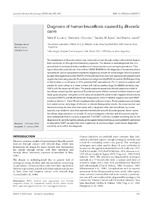Please use this identifier to cite or link to this item:
http://sgc.anlis.gob.ar/handle/123456789/356| Title: | Diagnosis of human brucellosis caused by Brucella canis | Authors: | Lucero, Nidia E. Escobar, Gabriela I. Ayala, Sandra M. Jacob, Néstor R. |
Keywords: | Brucelosis;Brucella canis;Humanos;Ensayo de Inmunoadsorción Enzimática;Zoonosis;Enfermedades de los Perros | Issue Date: | 2005 | Description: | The transmission of Brucella canis to man commonly occurs through contact with infected dogs or their secretions, or through direct laboratory exposure. The disease is underdiagnosed due to a general lack of serological testing facilities and misconceptions concerning its prevalence. This report shows the potential use of an indirect ELISA (IELISA) for the diagnosis of human brucellosis caused by B. canis in a population of patients negative by smooth-Brucella antigen tests but positive by rapid slide agglutination test (RSAT). One hundred and ten sera from asymptomatic people found negative by tests using smooth Brucella abortus antigen and by RSAT showed an IELISA specificity of 100 % when a cut-off value of 27 % positivity (%P) was selected. For 17 sera from patients with positive B. canis culture or in close contact with culture-positive dogs, the IELISA sensitivity was 100 % with the same cut-off value. The positive patients presented clinical symptoms similar to brucellosis caused by other species of Brucella and some of them received antibiotic treatment and made good progress. Using this cut-off value, we studied 35 patients with negative blood cultures but positive RSATs, and IELISA detected 18 as positive; of the 17 IELISA-negative, two were RSAT-positive at dilution 1 : 2 and 15 were weakly positive with pure serum. These samples were probably from patients at an early stage of infection or indicate false-positive results. No cross-reaction was observed among the sera from nine cases with a diagnosis other than brucellosis, but cross-reactivity was evident in sera from patients infected with smooth-Brucella species. Since routine brucellosis diagnosis does not include B. canis investigation, infection with this species may be more widespread than is currently suspected. The RSAT could be a suitable screening test for the diagnosis of B. canis human brucellosis, and a supplementary technique, such as IELISA, performed on all positive RSAT samples that were negative by B. abortus antigen could ensure diagnostic specificity and confirm the diagnosis. Fil: Lucero, Nidia E. ANLIS Dr.C.G.Malbrán. Laboratorio de Brucelosis; Argentina. Fil: Escobar, Gabriela I. ANLIS Dr.C.G.Malbrán. Laboratorio de Brucelosis; Argentina. Fil: Ayala, Sandra M. ANLIS Dr.C.G.Malbrán. Laboratorio de Brucelosis; Argentina. Fil: Jacob, Néstor R. Hospital Cosme Argerich. Infectologia; Argentina. |
URI: | http://sgc.anlis.gob.ar/handle/123456789/356 http://jmm.sgmjournals.org/content/54/5/457.full.pdf |
ISSN: | 0022-2615 | Rights: | 2006-05-31 info:eu-repo/semantics/embargoedAccess |
| Appears in Collections: | snrd Publicaciones INEI |
Files in This Item:
| File | Description | Size | Format | |
|---|---|---|---|---|
| JournalofMedicalMicrobiology,2005,54(5),457–461.pdf | 96.4 kB | Adobe PDF |  View/Open |
Page view(s)
444
checked on Jan 11, 2026
Download(s)
307
checked on Jan 11, 2026
Google ScholarTM
Check
Items in DSpace are protected by copyright, with all rights reserved, unless otherwise indicated.

